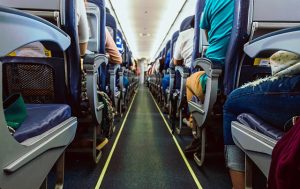 There’s a growing debate over whether or not airplanes should leave the middle seats open. Whether narrow-body or wide-body, most commercial airplanes rows consisting of at least three seats each. In the wake of COVID-19, some experts are calling for airplanes to close the middle seats. The general belief is that by closing the middle seats, passengers will be less likely to transmit infectious illnesses. So, should airplanes leave the middle seats open?
There’s a growing debate over whether or not airplanes should leave the middle seats open. Whether narrow-body or wide-body, most commercial airplanes rows consisting of at least three seats each. In the wake of COVID-19, some experts are calling for airplanes to close the middle seats. The general belief is that by closing the middle seats, passengers will be less likely to transmit infectious illnesses. So, should airplanes leave the middle seats open?
What the CDC Says About Middle Seats
A new study released by the U.S. Centers for Disease Control and Prevention (CDC) found a correlation between middle seat vacancies and lower rates of COVID-19 transmission. According to the CDC’s study, passengers are roughly 23% to 57% less likely to get sick when the middle seats are closed.
“When the infectious and other passengers who would have had middle seats were removed, leaving six infectious passengers out of 12 total passengers remaining in the window and aisle seats, a 57% exposure reduction was observed,” wrote the CDC in its study.
What Airlines Are Currently Doing to Protect Passengers
While most commercial airlines haven’t closed their middle seats, they’ve begun taking other measures to protect passengers from the spread of infectious illnesses. Passengers, for instance, are typically required to wear masks or facial coverings. Most commercial airlines won’t allow a passenger to board unless he or she is wearing a mask or facial covering. It’s important to note that the CDC’s study didn’t account for masks or facial coverings. The study was conducted without the use of masks or facial coverings.
In addition to requiring masks or facial coverings, many commercial airlines have adjusted their boarding process. Rather than boarding passengers from the front of the airplane to the back, they use an opposite boarding process. Boarding passengers from the back of the airplane to the front minimizes contact between passengers.
Some commercial airlines also conduct basic health screens during their boarding process. While passengers board the airplane, they’ll have their temperature checked. Passengers with a high temperature or otherwise exhibiting signs of illness may be prohibited from boarding.
Other commercial airlines have developed advanced cabin cleaning and sanitation techniques. Some of them, in fact, now use ultraviolet (UV) lights to neutralize garms. Whether they close their middle seats remains to be seen. With the CDC’s new study, some commercial airlines may take the initiative to close their middle seats in effort to further protect their passengers.



